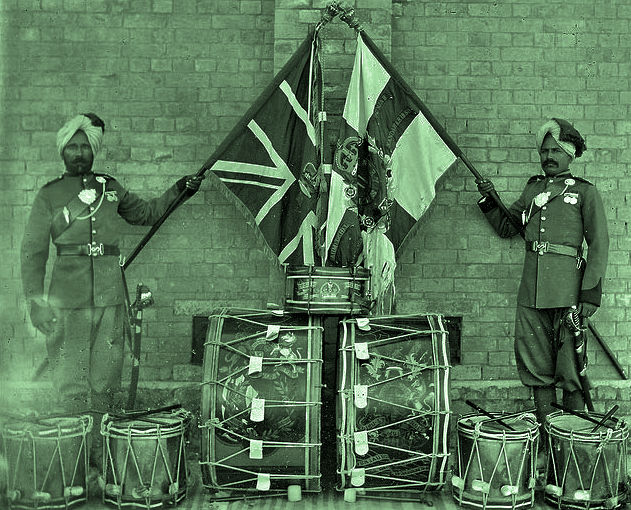 |
| British India c.1914 |
Editor's Note: During the Great War, the Indian Army would grow by a factor of six and—as the main contributor of this article Professor Corel Reigel argues—would prove a strategic manpower reserve for the British Empire throughout the conflict. Professor Reigel provides the first two parts of this three part series. The final artice, which covers the late war experience and aftermath for the Indian Army draws on other sources. MH
 |
| Redcoated Sepoys of the East India Company, 1804 |
By Corey W. Reigel, PhD, West Liberty University
Background
The Indian Army that would one day play a valuable role for the Allies in the First World War was started by the Honourable East India Company. It was raised as a small contingent under Robert Clive to oppose the Bengali rulers and the French in the struggle that ended with victory at Plassey in 1757. The East India Company had three “presidencies,” or branches, and each developed its own military force with detachments stationed in many locations around the country. As the Crown also had interests in India, there were also regular British units stationed in various spots from time to time. Following the suppression of the 1857 Sepoy Mutiny, the Company's charter was revoked and the Crown assumed authority in India, including control of the Company's forces. The future Indian Army would be built around those soldiers who had stayed loyal during the mutiny. Also, more British soldiers were sent to India, and all operational formations thereafter included both Indian and British troops. By 1914 the total force based in India totaled 240,000 men, almost the size of the home-based British Army. During the Great War, the Indian Army would grow by a factor of six.
 |
| Regimental Colors, 52nd Sikhs at Kohat, 1905 |
The Coming of the Great War
For the Indian soldiers who saw service from Flanders to China, in Africa and the Middle East, it truly was a world war. In a war of attrition, they provided the Allied effort with a strategic reserve of manpower. One justification for empire was the additional strength it would contribute. With a population of 320 million, India (see map above) sent one million men in uniform to most theaters of operations with 74,187 military deaths. Race and recent experiences were the primary criteria for the recruitment of the Indian Army. Although the Indian Army made a significant contribution to the Allied war effort in World War I, it was still a small number of soldiers relative to the population base of the Indian sub-continent. Most Europeans believed in the martial race theory, that some men were genetically superior soldiers, most often recently conquered opponents, and thus one upper limit was created by the British. Indian culture also imposed restrictions based on caste and religion. Thus, despite the substantial population, the colony of India had only a finite manpower base from which to serve the British Empire.
Most educated Europeans believed in a pseudo-scientific martial race theory, which is dismissed today. Modern conflict, the Great War itself a perfect example, took millions of ordinary men and quickly turned them into soldiers and sailors, with a wide variety of skills and tasks as required by industrialized warfare. Yet in 1914, the Indian Army was still more like a traditional colonial military of the Victorian era and was poorly prepared for a modern enemy like the German Army in Europe. Bullets and artillery shrapnel did not show a preference for certain ethnicities, but colonial government did, and thus the martial race theory was at the center of British recruitment, and most other Europeans practiced essentially the same thing. A mix of ad hominem and recent events, the Martial Race theory held that of all the Indian people only a few were of martial quality based on breeding, caste, and environment. In 1914 this favored the Dogras, the Garhwalis, the Gurkhas, the Kumaonis, the Pathans, and the Sikhs. Each company, but preferably entire battalions or regiments, was composed exclusively of men from the same caste or ethnicity. These soldiers were then deployed in a different region of India, among a different religion or ethnicity, as an alien battalion, with few connections to the local people but loyal to the British, who also encouraged a separate identity. So an example of divide and conquer, divide and rule might be a battalion each of Gurkha and Sikh infantry located in a Hindu or Muslim region.
 |
| 117th Mahrattas, NW Frontier, 1910 |
By 1914 the Indian Army consisted of 129 battalions of infantry or pioneers, 39 cavalry regiments, and 12 mountain artillery batteries (155,423 combatants), plus extensive support units. By World War I these were organized into nine divisions and several independent brigades. Each division had three infantry brigades made of one British and three Indian battalions, and one cavalry brigade composed of one British and two Indian regiments. A separate source of soldiers was the Princely States, whose units formed the Imperial Service Brigades. In theory the 29 Princely States were independent, or at least autonomous, and thus could maintain their own units, under British supervision. In 1914 they contributed 14 battalions and 20 cavalry regiments (22,515 men). Also, in an emergency the European population of India formed the Auxiliary Force, 42 battalions, 11 regiments, (33,677 men) mostly with the intention that they would serve in South Asia.
Read Part II, The Coming of War, HERE
Read Part III, Aftermath, HERE

Not only a manpower reserve, the Indian Army was responsible for all activity east of Suez and its General Staff in Shimla was in command throughout the region. Thus the British could minimize the impact of the Kut surrender on the grounds that it was an Indian Army defeat. This logic carried forward to the WWII debacles in Malaya and Singapore.
ReplyDelete